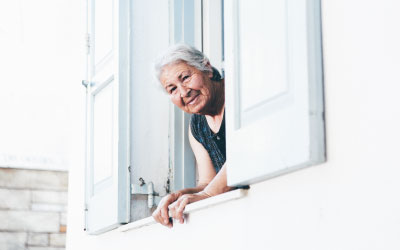How well do you know your neighbours?
In past generations, people constantly interacted face to face. They lived in close-knit, multigenerational villages. They knew their grocers and bankers, postal carriers and schoolteachers. And they could always ask a neighbour to borrow that cup of sugar.
Such village living is less common today. Why is this so? And why does it matter?
In this blog, we’ll discuss why multigenerational living communities are so important, and how they can help us all be healthier and live longer.
Intergenerational Living: Promoting
Vital Human Connection

Her research involves the Italian island of Sardinia, the only place where men live as long as women—and where there are 10 times as many centenarians as there are in North America. The Sardinians whom she studied exemplified intergenerational living: seniors were never alone or segregated with other elders, but enjoyed daily contact with younger people and fellow villagers.
Likewise, the Legacy Project found that active older adults with close multigenerational connections consistently report much less depression, better physical health, and higher degrees of life satisfaction. They tend to be happier with their present life and more hopeful for the future.
Could it be that as a society we are missing out on a huge potential symbiosis because we’ve become so age segregated? What mutual benefits just might rub off when our generations get back to living together more?
Humans Need Social Integration to be Healthy
We live in a health-obsessed age. People jump on the latest superfoods, fitness trends, and any other anti-aging secret weapon. Often overlooked is a key factor for longevity: social integration.
There is a distinction between socializing in person and online. Nowadays we are connected 24/7 through the Internet. All day and all night, we can communicate by text or email, FaceTime or Facebook. We might seem more connected than ever, but digital connectivity has its limits.

Our human connections—in person, not online—are more emotionally rewarding than likes and retweets. Moreover, with actual eye contact and visceral touch, significant physiological benefits occur.
For example, cortisol levels decrease, thereby reducing stress responses that contribute to serious illnesses. Studies have shown that people with strong social ties recover more successfully from cancer and heart disease. In addition, elderly people who are socially connected have less cognitive decline than those who are isolated.
Note that social integration encompasses not only spouses and close friends and family, but also connections within one’s community: neighbours, classmates, shopkeepers, baristas, and anyone seen on a regular basis.
Multigenerational Living: Creating A Modern Era Village
Today, urban living typically means moving to megacities or to suburbs. In metropolises of millions, people can feel lost in the crowd—while those who settle in suburbs live in disjointed unwalkable environments (or in their cars). In both cases, immediate families are separated by miles and even oceans.
Modern societies also typically divide communities by age: kids spend all day in schools, seniors live in retirement homes. Sometimes, especially in rapidly aging societies such as Japan, housing complexes become de facto senior communities, where the elderly are painfully lonely. Such age-based division detracts from the human experience.
With thoughtful planning, however, we can create housing alternatives that cultivate multigenerational communities. We can create a village within a city—particularly in dense urban areas, which one would think should naturally foster robust social interaction.
Conclusion
Why settle for disconnected living options? By reinventing village living for today’s world, people of all ages can once again learn from and nurture one another.
Be sure to sign up for our email list, and join Carpe Diem’s community. We’re committed to building out our plan to re-invent and create the modern village within the city. Let’s get back to the basics of healthy living.
Over to you! What are your thoughts on multigenerational living? Is it a living option you would consider for yourself? Let us know in the comments below.
